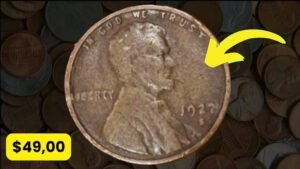What if that old penny sitting in your drawer was worth hundreds or even thousands of dollars today? For over a decade, Wheat Pennies have fascinated collectors and dreamers alike — simple copper coins that turned into miniature treasures. In this guide, we’ll uncover how their value has evolved over the last 13 years, which ones are worth the most, and how you can spot hidden gems in your own collection.
What Exactly Are Wheat Pennies?
Wheat Pennies, officially called Lincoln Wheat Cents, were minted from 1909 to 1958. They feature President Abraham Lincoln on the front and two stalks of wheat on the back — a symbol of prosperity. What makes them so special today isn’t just their age, but their composition and rarity. Made mostly of 95% copper, they’ve become a nostalgic and valuable link to America’s coinage history.
A Brief History of the Wheat Penny
The Lincoln Wheat Cent was introduced in 1909 to celebrate the 100th anniversary of Abraham Lincoln’s birth. Designed by Victor David Brenner, it was the first US coin to feature a real person. During World War II, copper shortages led to the creation of the 1943 Steel Cent, a unique zinc-coated steel version that remains one of the most collectible error coins in circulation today.
How Wheat Penny Values Have Changed Over 13 Years
Over the past decade, the value of Wheat Pennies has climbed steadily. Fueled by growing interest in coin collecting and rising metal prices, even common dates are worth more than face value. Rarer editions, however, have skyrocketed. Below is a comparison of average price growth over the past 13 years.
Average Wheat Penny Value Growth (2012–2025)
| Year | Common Circulated | High-Grade Uncirculated | Rare Key Dates (Avg.) |
|---|---|---|---|
| 2012 | $0.05 – $0.15 | $1 – $3 | $200 – $1,200 |
| 2015 | $0.10 – $0.25 | $2 – $5 | $250 – $1,500 |
| 2020 | $0.15 – $0.35 | $3 – $7 | $300 – $2,000 |
| 2025 | $0.25 – $0.50 | $5 – $10+ | $400 – $3,500+ |
| As you can see, rare Wheat Pennies have tripled or quadrupled in value over the past decade, while even common pieces have become more desirable to hobbyists and beginners. |
The Most Valuable Wheat Pennies Today
While every Wheat Penny holds sentimental and historical value, some are true collector’s dreams. Below are the standout coins in today’s market.
Top Valuable Wheat Pennies (Current Estimates)
| Year | Mint Mark | Feature | Estimated Value |
|---|---|---|---|
| 1909-S VDB | San Francisco | Designer’s initials | $800 – $3,500+ |
| 1914-D | Denver | Low mintage | $250 – $3,000 |
| 1922 No D | Denver | Missing mintmark error | $600 – $2,000 |
| 1943 Copper | Philadelphia | Wrong metal composition | $100,000+ |
| 1955 Double Die | Philadelphia | Double image error | $1,000 – $25,000 |
| 1944 Steel | Philadelphia | Transitional minting | $10,000 – $75,000 |
| 1931-S | San Francisco | Low production year | $75 – $150 |
Why Wheat Pennies Remain Popular Today
There’s something magical about finding a Wheat Penny in your pocket change — a tangible piece of history. Collectors are drawn to their warm copper color, classic design, and affordable entry point. Plus, they’ve proven to be a stable investment, often outperforming modern commemorative coins in percentage growth over time.
Expert Tips: How to Identify and Preserve Valuable Wheat Pennies
- Check the Date and Mintmark: Look closely under the date for mint letters like “S” (San Francisco) or “D” (Denver).
- Inspect for Errors: Double dies, missing letters, or wrong metals can indicate major value.
- Avoid Cleaning: Even dirty coins can lose 50% of their value if cleaned.
- Store Properly: Use coin flips or albums to prevent oxidation and scratches.
- Get Graded: Professional grading from NGC or PCGS confirms authenticity and raises resale value.
Fascinating Facts About Wheat Pennies
- A 1943 Copper Wheat Penny once sold for $1.7 million at auction.
- The first Lincoln cent (1909-S VDB) was pulled early due to complaints about Brenner’s initials.
- Over 25 billion Wheat Pennies were minted between 1909 and 1958.
FAQs
Q: Are all Wheat Pennies valuable?
A: No, but nearly all are worth more than face value, especially in good condition.
Q: Can you still find them in circulation?
A: Rarely, but they do occasionally appear in change or bank rolls.
Q: Which Wheat Penny is worth the most?
A: The 1943 Copper Wheat Penny holds the record, valued in the six-figure range.
Conclusion: A Penny That Dreams Are Made Of
The Wheat Penny is more than just a coin — it’s a time capsule of American history and an attainable dream for collectors. In the last 13 years, their value has surged, proving that even the smallest pieces of change can hold incredible worth. Whether you’re a lifelong collector or just starting out, there’s never been a better time to rediscover these classic coins. So go ahead — check your old jars and coin boxes. That forgotten penny might just be your lucky find.



